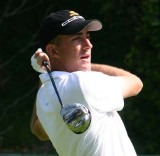 The Golf Channel is re-airing the final two hours of the U.S. Open telecast Tuesday at 7:30 p.m. EST and again at 11:00 p.m..
The Golf Channel is re-airing the final two hours of the U.S. Open telecast Tuesday at 7:30 p.m. EST and again at 11:00 p.m..
Here's a recap, with a few things you might want to look for Tuesday night when Mickelson reaches 18 tee (for all 70 million of you Golf Channel subscribers homes reached).
I'm using TiVo's clock here, not a stopwatch, but the general times should be enough to give an impression how quickly this transpired (when you consider how long Mickelson and "Bones" usually debate shots):
6:51: Ogilvy's second shot into 18 is from only 145, and he catches it so crisp that the ball spins back off the green. My initial impression was that it landed near the top of the upslope and simply didn't quite reach the plateau, and then rolled back. On second viewing, he remarkably put too much spin on it.
6:52: Phil tees off, the blimp shot shows the enormous merchandise tent hugging the tree line. Up at the green, NBC has a stellar camera view of the brutally difficult shot facing Ogilvy.
6:56:30: Ogilvy surveys to hit his incredible wedge shot, Phil is walking forward to see the 18th green while Bones and the USGA's Mike Davis are among those doing crowd control.
6:57: Mickelson reaches a point where he can see the green, and is "looking up ahead" according to Dan Hicks. We see Ogilvy's amazing wedge shot
6:58:30: Ogilvy makes the incredibly difficult 5-6 footer (it looked longer this time around). Cut to Phil who acknowledges something Bones says as they walk back to their ball to play the second shot. As they walk, Bones offers a yardage, Mickelson turns to check the line he wants to take.
6:59: They arrive at the ball, Phil looks at his shot, Bones is picking up the bag that is over in the graduated rough and when he arrives, says something that NBC's mikes pick up. The crowd's "go Phil" calls make it impossible to make out what is said. Bones then gives a yardage and Phil pulls the club with almost no discussion. Bones moves away.
7:00: Phil hits his second shot that hits the tree. The crowd rushes forward as do officials and Mickelson.
7:01: Phil has surveyed up ahead and is now walking back to the location of what will be his third shot as crowd order is being restored. As he's walking back to the ball, a kid asks "can you sign this," to which a few people tell him "not now," and Phil does give the kid a quick look. Bones, meanwhile, is looking for a yardage, while photographers and someone with a small digital video camera on a tripod are set up behind Phil.
7:02: Bones says he has 65 to the front, Phil asks are you "thinking this or 9?" I believe Bones says something like "65 to the front means 73 to the hole" and then very clearly, "I'm definitely not thinking 9 at all." Phil says "okay," and within seconds pulls the trigger on shot 3 that buries in the greenside bunker.
It's amazing to see how two professionals who grind out the decision making, take so little time to engage in their normal debate on either shot. The situation was certainly chaotic, but it is fascinating to see how the U.S. Open pressure took even these two elite professionals out of their routine.
Also, I'm having a hard time letting the tent placement go even though I'm thrilled that Ogilvy was the beneficiary of the USGA's greed, as evidenced by this post and follow up commentary from someone who was there.
Check out these Google Earth images of 18 at Winged Foot, taken in early spring before the tree leaves have returned. Envision the lovely Champions tent where Phil's drive hit and then bounced backwards (and to the right). Try to picture that drive not hitting a tent, and I'm pretty confident it ends up in 11 East's fairway with a much better view of 18 West's green.

(click image to enlarge)
(click image to enlarge)
Now, I'm not bringing this up to pick on the USGA's iffy tent location selection or the fact that they've been allowing corporate hospitality to get so close to play since 2000 at Pebble Beach.
Okay, I am.
But ignore those questions, and simply consider if Mickelson would have had a much easier shot into 18 had his tee shot not hit the Champions tent, and had been allowed to end up somewhere on 11 East?
In the 1929 Open? Absolutely.
In 1984? I don't know if the trees were too thick, or what the USGA had in the way of tents on 11 East. But somehow, I suspect there wasn't a giant corporate tent so close to play.















